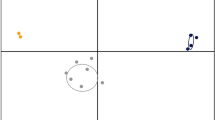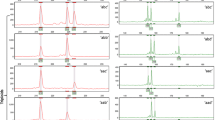Abstract
Polyploidy plays a pivotal role in plant evolution. However, polyploids with polysomic inheritance have hitherto been severely underrepresented in plant population genetic studies, mainly due to a lack of appropriate molecular genetic markers. Here we report the establishment and experimental validation of six fully informative microsatellite markers in tetraploid gynodioecious Thymus praecox agg. Sequence data of 150 microsatellite alleles and their flanking regions revealed high variation, which may be characteristic for polyploids with a reticulate evolutionary history. Understanding the patterns of mutation (indels and substitutions) in microsatellite flanking-sequences was a prerequisite for the development of co-dominant markers for fragment analyses. Allelic segregation patterns among progeny arrays from ten test crosses revealed tetrasomic inheritance in T. praecox agg. No evidence of frequent double reduction was detected. Polymerase chain reaction (PCR) based dosage effects allowed for precise assignment of allelic configuration at all six microsatellite loci. The quantification of allele copy numbers in PCR was verified by comparisons of observed and expected gametic allele frequencies and heterozygosities in test crosses. Our study illustrates how PCR based markers can provide reliable estimates of heterozygosity and, thus, powerful tools for breeding system and population genetic analyses in polyploid organisms.

Similar content being viewed by others
References
Bailey MF, Delph LF, Lively CA (2003) Modeling gynodioecy: novel scenarios for maintaining polymorphism. Am Nat 161:762–776
Balloux F, Lugon-Moulin N (2002) The estimation of population differentiation with microsatellite markers. Mol Ecol 11:155–165
Barrett SCH, Kohn JR (1991) Genetic and evolutionary consequences of small population size in plants: implications for conservation. In: Falk DA, Holsinger KE (eds) Genetics and conservation of rare plants. Oxford University Press, Oxford, pp 3–30
Bennett MD (2004) Perspectives on polyploidy in plants—ancient and neo. Biol J Linn Soc 82:411–423
Bever JD, Felber F (1992) The theoretical population genetics of autopolyploidy. In: Antonovics J, Futuyma D (eds) Oxford surveys in evolutionary biology, vol 8. Oxford University Press, New York, pp 185–217
Bischof-Deichnik C, Holtuijzen J, Stahl-Biskup E (2000) Multivariate statistical analysis of the essential oil composition of Thymus praecox Opiz ssp. polytrichus (Kern. ex Borb.) Ronn. collected in the Tyrolean Alps. Flavour Frag J 15:1–6
Buteler MI, Jarret RL, LaBonte DR (1999) Sequence characterization of microsatellites in diploid and polyploid Ipomoea. Theor Appl Genet 99:123–132
Charlesworth D, Laporte V (1998) The male-sterility polymorphism of Silene vulgaris: analysis of genetic data and comparison with Thymus vulgaris. Genetics 150:1267–1282
De Silva HN, Hall AJ, Rikkerink E, McNeilage MA, Fraser LG (2005) Estimation of allele frequencies in polyploids under certain patterns of inheritance. Heredity 95:327–334
Dettman JR, Taylor JW (2004) Mutation and evolution of microsatellite loci in Neurospora. Genetics 168:1231–1248
Esselink GD, Nybom H, Vosman B (2004) Assignment of allelic configuration in polyploids using the MAC-PR (microsatellite DNA allele counting-peak ratios) method. Theor Appl Genet 109:402–408
Estoup A, Martin O (1996) Marquers microsatellites: isolement à l’aide de sondes non-radiactive, caractérisation et mise au point. Institut National Agronomique Paris Grignon (INA-PG), Paris
Flajoulot S, Ronfort J, Baudouin P, Barre P, Huguet T, Huyghe C, Julier B (2005) Genetic diversity among alfalfa (Medicago sativa) cultivars coming from a breeding program, using SSR markers. Theor Appl Genet 111:1420–1429
Galloway LF, Etterson JR, Hamrick JL (2003) Outcrossing rate and inbreeding depression in the herbaceous autotetraploid, Campanula americana. Heredity 90:308–315
Hansson B, Westerberg L (2002) On the correlation between heterozygosity and fitness in natural populations. Mol Ecol 11:2467–2474
Hardy OJ, De Loose M, Vekemans X, Meerts P (2001) Allozyme segregation and inter-cytotype reproductive barriers in the polyploid complex Centaurea jacea. Heredity 87:136–145
Jacobs MS, Wade MJ (2003) A synthetic review of the theory of gynodioecy. Am Nat 161:837–851
Jalas J (1970) Thymus sectio Serpyllum in the Southern French Alps (Alpes françaises du Sud). Veröff Geobot Inst ETH 43:186–203
Jalas J (1971) Notes on Thymus L. (Labiatae) in Europe. II. Comments on species and subspecies. Bot J Linn Soc 64:247–271
Jalas J, Kaleva K (1970) Supraspezifische Gliederung und Verbreitungstypen in der Gattung Thymus L. (Labiatae). Feddes Repert 81:93–106
Julier B, Flajoulot S, Barre P, Cardinet G, Santoni S, Huguet T, Huyghe C (2003) Construction of two genetic linkage maps in cultivated tetraploid alfalfa (Medicago sativa) using microsatellite and AFLP markers. BMC Plant Biol 3:9
Landergott U, Holderegger R, Kozlowski G, Schneller JJ (2001) Historical bottlenecks decrease genetic diversity in natural populations of Dryopteris cristata. Heredity 87:344–355
Lopez-Pujol J, Bosch M, Simon J, Blanche C (2004) Allozyme diversity in the tetraploid endemic Thymus loscosii (Lamiaceae). Ann Bot 93:323–332
Luo ZW, Zhang Z, Zhang RM, Pandey M, Gailing O, Hattemer HH, Finkeldey R (2006) Modeling population genetic data in autotetraploid species. Genetics 172:639–646
McQuown E, Gall GAE, May B (2002) Characterization and inheritance of six microsatellite loci in lake sturgeon. Trans Am Fish Soc 131:299–307
Miller JS, Venable DL (2000) Polyploidy and the evolution of gender dimorphism in plants. Science 289:2335–2338
Nybom H, Esselink GD, Werlemark G, Vosman B (2004) Microsatellite DNA marker inheritance indicates preferential pairing between two highly homologous genomes in polyploid and hemisexual dog-roses, Rosa L. Sect. Caninae DC. Heredity 92:139–150
Olson MS (1997) Bayesian procedures for discriminating among hypotheses with discrete distributions: inheritance in the tetraploid Astilbe biternata. Genetics 147:1933–1942
Pannell JR, Obbard DJ, Buggs RJA (2004) Polyploidy and the sexual system: what can we learn from Mercurialis annua? Biol J Linn Soc 82:547–560
Ritland K (1990) Inferences about inbreeding depression based on changes of the inbreeding coefficient. Evolution 44:1230–1241
Ronfort J (1999) The mutation load under tetrasomic inheritance and its consequences for the evolution of the selfing rate in autotetraploid species. Genet Res 74:31–42
Ronfort J, Jenczewski E, Bataillon T, Rousset F (1998) Analysis of population structure in autotetraploid species. Genetics 150:921–930
Rossetto M, McNally J, Henry RJ (2002) Evaluating the potential of SSR-flanking regions for examining taxonomic relationships in the Vitaceae. Theor Appl Genet 104:61–66
Soltis PS, Soltis DE (2000) The role of genetic and genomic attributes in the success of polyploids. Proc Natl Acad Sci USA 97:7051–7057
Soltis DE, Soltis PS, Tate JA (2004) Advances in the study of polyploidy since Plant Speciation. New Phytol 161:173–191
Stahl-Biskup E, Sáez F (2002) Thyme: the genus Thymus. Taylor and Francis, London
Truong C, Palme AE, Felber F, Naciri-Graven Y (2005) Isolation and characterization of microsatellite markers in the tetraploid birch, Betula pubescens ssp. tortuosa. Mol Ecol Notes 5:96–98
Tutin TG, Heywood VH, Burges NA, Moore DM, Valentine DH (1972) Flora Europaea, vol 3. Cambridge University Press, Cambridge
Wagner A, Blackstone N, Cartwright P, Dick M, Misof B, Snow P, Wagner GP et al. (1994) Surveys of gene families using polymerase chain reaction: PCR selection and PCR drift. Syst Biol 43:250–261
Wendel JF (2000) Genome evolution in polyploids. Plant Mol Biol 42:225–249
Acknowledgments
We thank John D. Thompson, Nike Böger and Zsófia Hock for collecting plant material from Southern France, Ireland and Hungary, respectively, and Jean-François Manen for introduction to primer design. We also thank François Felber, Hilde Nybom, John D. Thompson and two anonymous reviewers for helpful comments on the manuscript. This work was funded by the Swiss National Science Foundation (Grant No. 3100–066852.01).
Author information
Authors and Affiliations
Corresponding author
Additional information
Communicated by H. Nybom
Electronic supplementary material
Rights and permissions
About this article
Cite this article
Landergott, U., Naciri, Y., Schneller, J.J. et al. Allelic configuration and polysomic inheritance of highly variable microsatellites in tetraploid gynodioecious Thymus praecox agg.. Theor Appl Genet 113, 453–465 (2006). https://doi.org/10.1007/s00122-006-0310-6
Received:
Accepted:
Published:
Issue Date:
DOI: https://doi.org/10.1007/s00122-006-0310-6




